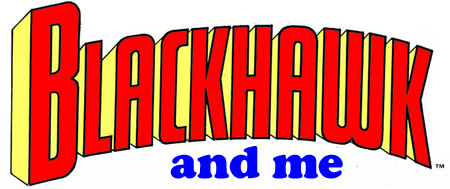Before you read this, you might want to read Part 1, Part 2 and Part 3…

George Kashdan left his job as a DC editor in early 1968, just as Editorial Director Irwin Donenfeld was hiring a new editor — Dick Giordano, who had previously been the executive editor at Charlton Comics. Giordano took over some of the comics Kashdan had been editing including Blackhawk. One of his many immediate problems was what the heck to do with that comic. The story arc that turned the combat team into a super-hero team had clearly not worked.
The first day in his new job, Dick was sitting at the desk he'd inherited from Kashdan and…well, wait. I'll let my friend Marv Wolfman tell you what happened. Marv was not yet a professional comic book writer but he soon would be…
I was a huge Blackhawk fan and was livid when they changed the characters into what they called, and we all agreed, were "the Junk-Heap Heroes." I was still a fan producing only fanzines but decided to show them "how it should be done." Julie Schwartz had sent me several comic scripts because I wrote letters to his books. Thanks to them, I knew what a script looked like so I wrote up a story. Yes, I was a part of the MBGA movement — Make Blackhawk Great Again.
I sent it to the comic's editor, knowing for sure it was great. And I never heard back. Weeks went by. No letter back. Continents rose and sank. No letter back.
A year or so passed by and still no response. Eventually, the editor on Blackhawk was replaced with a new editor, Dick Giordano, and on day one, he found a never-opened manila envelope in the back of his desk drawer.
Dick opened it and it was my script. He had met me at a comic con and I had sent him my fanzines so to some extent, he knew me. He called and asked if I still wanted him to read it and I said yes. Dick liked it and bought the story but he assigned the dialog job to Bob Haney, who if memory serves was the current writer on Blackhawk. Still, it was my first sale and I was thrilled.
To this day, I have no clue why the previous editor kept the still-sealed envelope with my script in his desk but never opened it. If he wasn't interested in reading it, why didn't he throw it out?
Marv's script was a really impressive first sale. It was Blackhawk done the way folks like me who loved the old Blackhawk wanted to see the new Blackhawk done.
But Giordano had a problem getting it drawn. The comic's regular artists, Dick Dillin and Chuck Cuidera, were no longer available to him. Dillin, for reasons I'll explain in the next chapter, was now being assigned to super-hero books at DC. I'll also tell you in the next part what became of Chuck Cuidera. A new artist was needed.
Giordano had a thought: The best Blackhawk comics of the forties and early fifties had been drawn by Reed Crandall, who was now living in Wichita, Kansas and doing the occasional art job for Warren's Creepy and Eerie magazines and for a Flash Gordon comic book published by a small firm called King Comics. King had recently shut down so, Dick thought, Mr. Crandall might be in need of work. Dick called Crandall to see if he was available and interested.
Mr. Crandall was both so they agreed on what he would be paid and on the deadline by which he would deliver the finished art, and Giordano mailed the script to Kansas. He was very pleased with how things were working out…and confident that the book, one of the first he was assembling for his new employer, would be very impressive.
And then like Marv Wolfman, he waited. And waited. The deadline came and went with no artwork arriving from Reed Crandall.
With the printer deadline growing near, Dick kept phoning, trying to reach Crandall to find out when he'd be getting the pages. After several days, Crandall finally answered the phone and when Dick told me this story — still trembling a bit from the memory — he said, "I really didn't understand why but he hadn't started on it and was not going to. So I was in deep trouble." Dick was in deeper trouble when he realized that he didn't have a copy of the script — or if he did, couldn't find it…and Bob Haney didn't have a carbon copy either. This was way before computers or even cheap copiers.
First things first, he needed an artist. This was also before FedEx and Dropbox so it would help if the artist lived somewhere near Kansas. That is, assuming Reed Crandall could be persuaded to mail the script to that artist. Dick remembered that while he was in charge at Charlton, there was an artist who lived in Texas who had done some amazing deadline-saving jobs. That artist was Pat Boyette and he lived in San Antonio, a little over 600 miles from Wichita.
The fastest mail at the time was Special Delivery which would take a lot less time to get the script to San Antonio than it would to get it back to New York where the DC offices were located. Dick called Pat, who immediately agreed to drop everything else in his life and to pencil, letter and ink the story as fast as humanly possible. Fortunately, he was a fan of the old Blackhawk comics and had some around so he had reference on the characters.
Also fortunately: When Dick called Reed Crandall, Crandall agreed to send the script via Special Delivery to Pat. While he waited for it to arrive, Pat drew a cover for the book based on Dick's over-the-phone description of the villain and what kind of scene he had in mind. Pat even designed a new title logo for the comic, though the lettering at the bottom was done in New York by Gaspar Saladino.

How long did it take Pat Boyette to draw Blackhawk #242? Marv remembers it as a weekend. Dick thought it was about four days. When I asked Pat about it once, he said, "I have no idea. I just knew I didn't eat or sleep much. It might have been three or four days." To give you some measure of how fast that was, there was another fine artist who worked for Charlton and later worked for DC. His name was Jim Aparo and he would pencil, letter and ink one page a day. He was not considered slow. That was about average.
For that issue of Blackhawk, Pat had to do the cover and a 23 page story. There were two half-page ads in the story and one third-page ad so it was really 21 and two-thirds pages…but even that seems humanly-impossible. And remember: This was a comic about seven heroes plus Lady Blackhawk and a whole lotta villains and airplanes. It wasn't about one guy wandering through the desert.
And yeah, you could see in places it was rushed…but I remember buying this comic and thinking it was terrific. The next issue, which Haney wrote and which Pat had some time to draw, looked even better. That was #243 and it was the last issue of Blackhawk at the time. Marv Wolfman wasn't involved with that issue but having "broken in" with the previous one, he was now positioned to do more for DC Comics…which he did, for Giordano and other editors there. He's had a fabulous career since and it all started because George Kashdan didn't fully clean out his desk.
Axing Blackhawk when they did meant that DC management did not even wait for sales figures on the new "old look" before terminating the book. They just looked at the numbers of the last few super-hero issues and said, "It's done."
Dick did not recall those last two selling well enough to reverse that decision. I have a belief that during this period, DC Management was way too quick to give up on a new comic or even a new version of an old one. One tepid sales report and they'd cancel a book like Anthro or Bat Lash or Secret Six without giving readers a chance to discover all that new wonderment. The return of Blackhawk to its roots might well have been another example of that.
It was, of course, not the end of Blackhawk. It was just the end of Blackhawk for eight years. Our story will continue.
Click here to jump to the next part of this article
